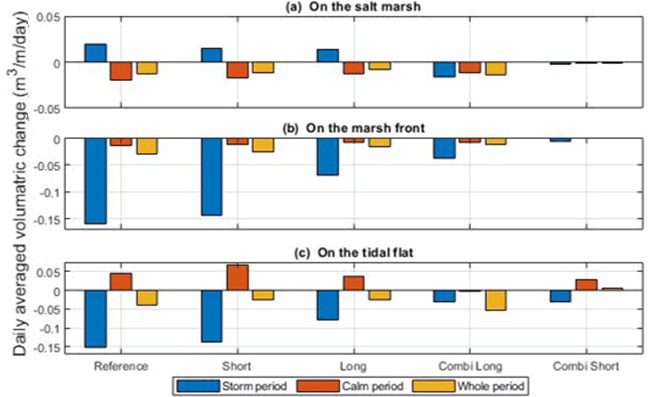R.W.A. Siemes1,2, R.J. Daggenvoorde2, B.W. Borsje1, S.J.M.H. Hulscher1
1 University of Twente,
2 HKV,
Introduction
Salt marshes are more and more recognised as resilient and sustainable supplements to traditional coastal flood protection structures. Nevertheless, many salt marshes face severe erosion. There is a general consensus that creating an area which is sheltered from high energetic conditions improves the potential for salt marsh growth. However, little proof is provided on the explicit influence of artificial structures to promote salt marsh growth. We investigated how engineering solutions can be used to steer the morphological development of salt marshes.
Methods
A morphological model (Delft3D Flexible Mesh) was applied which enables the analysis of various artificial structures. A small salt marsh in the Wadden Sea was modelled. This marsh has seen heavy erosion (retreat rate of 0.9m/year) since maintenance of its sedimentation field and groyne were halted. In the model, we simulate daily and storm conditions which occurred during the month of October 2017.
Results
The simulated hydrodynamics were validated with measured data. This showed that the model performed well in simulating these hydrodynamics conditions. Key processes relevant for the morphological development of salt marshes are captured and several simulated morphological patterns are observed and identified in literature.
| Name | Description | |
| Short | A groyne of 2.5m high, 300 m long and perpendicular to the coast | |
| Long | A groyne of 2.5m high, 900 m long and perpendicular to the coast | |
| Combi Long | Combination of the long groyne and a proposed sedimentation field | |
| Combi Short | Combination of the short groyne and a traditional sedimentation fiel |
Table 1. An overview of the artificial structure configurations implemented in the model simulation.
The calibrated model showed that salt marsh development can be stimulated by artificial structures. The impact of four configurations of artificial structures (Table 1) were analysed. Results hereof are displayed in Figure 1 and show that the artificial structures reduce erosion on the marsh front and tidal flat. Furthermore, most structures are able to increase net accretion on the tidal flat, demonstrating their potential for stimulating salt marsh growth. In addition, results showed that the marsh accretes during storm events. This indicates that salt marshes may provide a resilient supplement to hard structures to improve coastal safety in the face of increasing storminess. However, the artificial structures do reduce accretion on the marsh during the storms.

Figure 1 Simulated daily and length averaged volumetric change (a) on the salt marsh, (b) on the salt marsh front and (c) on the tidal flat. The storm period contains the storms of 4-5 October 2017 and 27-28 October 2017. The calm period is from 8 to 21 October. The whole period is the whole month of October 2017.
I. Surname1*, F.N. Another-Surname2 , Y. Next-Surname2
1 University Name, Country; 2 Organization Name, Country
* Corresponding author: mail.name@organization.org


